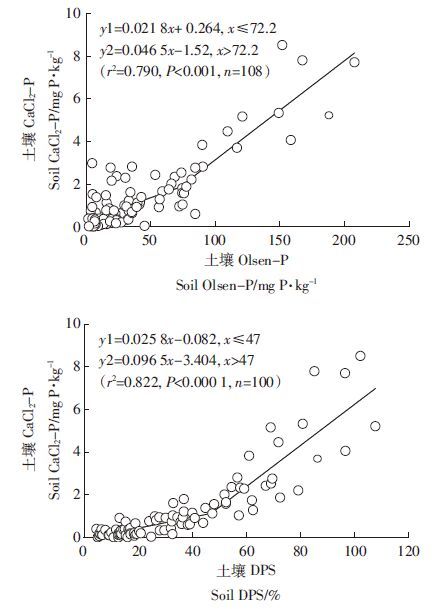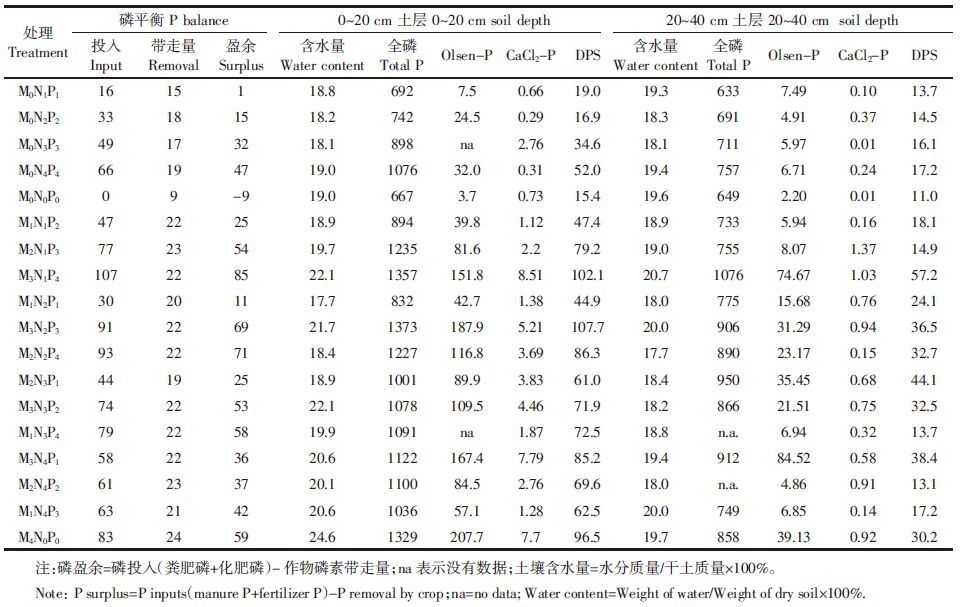文章信息
- 严正娟, 陈硕, 周怀平, 杨振兴, 陈清
- YAN Zheng-juan, CHEN Shuo, ZHOU huai-ping, YANG Zhen-xing, CHEN Qing
- 施用粪肥对农田土壤磷素累积和饱和度增加速率的影响
- Effects of manure applications on rates of phosphorus accumulation and phosphorus saturation degree increase in arable soils
- 农业环境科学学报, 2016, 35(6): 1110-1118
- Journal of Agro-Environment Science, 2016, 35(6): 1110-1118
- http://dx.doi.org/10.11654/jaes.2016.06.013
文章历史
- 收稿日期: 2015-12-12
2. 山西省农科院农业环境与资源研究所, 太原 030031
2. Institute of Agricultural Environment and Resource, Shanxi Academy of Agriculture Sciences, Taiyuan 030031, China
我国农田土壤磷素平衡自20世纪70年代末由亏缺转为盈余,单位耕地面积磷盈余量从80年代初6.1 kg P·hm-2增加到目前26.1 kg P·hm-2 [1]。MacDonald等[2]分析了全球农田磷平衡状况,认为我国是目前磷盈余最严重的国家之一。当土壤磷素供应不足时,磷盈余可以明显改善农田土壤磷素供应,我国目前土壤磷素状况总体处于中等或中等偏上水平[3],但是在集约化经济作物种植地区,常年施用有机肥料导致土壤磷素累积程度严重,由此带来的环境问题尤为突出[4]。通过长期定位试验能够明确土壤磷累积和磷素盈余之间的线性相关性[5-6],例如Cao等[7]采用土壤Olsen-P变化,建立与化肥磷素盈余之间的线性关系,表明每年1 kg P·hm-2磷素盈余导致粮田表层土壤Olsen-P增加量为0.014~0.057 mg P·kg-1。这种定量关系,即累积速率,可用于预测连续施磷和种植作物条件下土壤磷素累积变化,对于合理制定磷素管理策略有很好的量化预测作用。土壤磷饱和度(DPS,degree of P saturation)是同时考虑土壤磷水平和磷素固持能力的一个综合指标,与土壤磷的移动性及其通过径流和淋洗过程损失的磷素存在显著的相关关系,是评价土壤磷素损失风险的关键指标[8-11]。已有研究表明,土壤连续高量磷素累积导致了土壤磷饱和度显著增加,迅速增加了磷素在土壤中的移动性[12-14]。因此,建立土壤磷饱和度变化和磷素盈余之间的定量关系,可为直接预测农田土壤磷素累积的环境风险提供支持。
随着养殖业的快速发展,施用粪肥是减少养殖场污染、替代化肥和实现化肥减施的关键途径。然而,长期大量施用粪肥是导致土壤中磷素累积的重要原因[4, 15-17]。施用粪肥除了可以增加土壤磷库外,同时也能改变土壤理化性质、土壤生物和非生物过程,促进土壤中不同形态磷之间的转化,进而影响磷素在土壤中的移动性。由于粪肥中的腐植酸与Ca、Fe和Al形成螯合物,或通过腐植酸及小分子有机酸等与磷酸根离子竞争吸附位点,施用粪肥可减少磷素固定,促进磷素释放[18-20];粪肥带入的钙镁、分解过程产生的小分子有机酸以及对土壤pH的缓冲作用等均会影响磷素的沉淀-溶解过程,促进磷素转化[21-24];粪肥本身会带入一些微生物和酶,同时碳源物质和其他养分的添加,也能刺激土壤微生物活性,促进有机磷转化[25-27]。这些转化过程必然影响土壤磷累积和DPS增加与磷素盈余之间的定量关系。施用粪肥在减少土壤对磷素的固定作用、维持更高的土壤活性磷的同时,却导致磷素损失风险更高[13, 28-29]。因此,本研究基于长期定位试验,对比分析了施用和不施粪肥情况下,土壤磷累积和DPS增加与磷素盈余之间的定量关系,揭示施用粪肥对土壤磷素累积和饱和度增加速率的影响,为合理地管理农田磷养分、降低面源污染提供理论依据。
1 材料与方法 1.1 供试地点及土壤试验位于山西省寿阳县宗艾镇宗艾村北坪地(东经113°06′39″、北纬37°58′24″,海拔1130 m)。土壤类型为褐土(褐土性土),成土母质为马兰黄土,黄土台塬。1992年4月试验开始时土壤的基础理化性质见表 1和表 2。
供试作物为春玉米,一年一作,4月15—28日播种,9月20日—10月10日收获。1992—1996年供试品种烟单14号,1997—2003年供试品种晋单34号,2004—2011年供试品种强盛31号,种植密度为每公顷4.95~5.25万株;2012—2013年供试品种晋单81号,种植密度为每公顷6.60万株。
1.3 试验处理试验设计采用氮、磷和有机肥三因素四水平正交设计,另设对照和高量粪肥区,共18个处理(表 3),小区面积66.7 m2,试验用地总面积1800 m2。粪肥为干牛粪,历年氮、磷、钾的平均含量分别为4.45 g N·kg-1、0.62 g P·kg-1和20.2 g K·kg-1,所用氮肥和磷肥分别为尿素(46% N)和过磷酸钙(14% P2O5)。秋季结合耕翻地将肥料一次施入。

|
于2013年玉米收获后分别采集0~20 cm 和20~40 cm 土层土样,同时收集了1992年的基础样品和历年作物养分带走量数据(养分带走量由植株干重和含磷量计算而得)。测定了土壤样品含水量、全磷、Olsen-P、CaCl2-P和DPS。土壤含水量采用烘干法(105 ℃下烘 24 h)测定;全磷采用H2SO4-H2O2消化-钼锑抗比色法测定[30];Olsen-P用0.5 mol·L-1 NaHCO3(pH 8.5)溶液提取(土水比1∶20)后采用钼锑抗比色法测定[31];CaCl2-P用0.01 mol·L-1 CaCl2溶液提取(土水比1∶5)后采用孔雀绿比色法测定[32-33]。
薛巧云[34]对北方和西北地区75个石灰性土壤进行研究,得到DPS与土壤P、Ca、Mg含量的定量关系式:
DPS(%)=(M3-P)/[(0.039(M3-Ca)+0.462(M3-Mg)]×100
式中:M3-P、M3-Ca、M3-Mg分别为用M3浸提液提取(0.20 mol·L-1 HOAc-0.25 mol·L-1 NH4NO3-0.015 mol·L-1 NH4F-0.013 HNO3-0.001 mol·L-1 EDTA),ICP测定的土壤P、Ca和Mg含量,mmol·kg-1。
土壤磷素变化(mg P·kg-1·a-1)=(Pend-Pinitial)/22
式 中:Pend和Pinitial分别为2013年玉米收获后和1992年试验开始时土壤全磷、Olsen-P、CaCl2-P含量,mg P·kg-1。
土壤DPS变化(%·a-1)=(Dend-Dinitial)/22
式中:Dend和Dinitial分别为2013年玉米收获后和1992年试验开始时土壤DPS值,%。
DPS、Olsen-P与流失磷(径流或淋洗液)或水溶性磷(H2O-P或CaCl2-P)之间均存在一个拐点值,当DPS、Olsen-P高于各自拐点值时,流失磷或水溶性磷含量随DPS、Olsen-P增加急剧增加,进而加大了磷素进入水体的风险[33, 35-36],此拐点值则为土壤磷的环境阈值。
1.5 统计分析本研究利用Microsoft Excel 2010对所有数据进行数据库建立和分析。分别运用SAS(Version 9.3,SAS Institute,2011)和SigmaPlot(Version 10.0,Systat Software Inc.,2006)软件进行相关分析的显著性检验和分段线性方程拟合。
2 结果与分析 2.1 施用粪肥对土壤磷素盈余和累积的影响基于本试验历年玉米收获后采集的土样测定值,分别以DPS和Olsen-P为横坐标、CaCl2-P为纵坐标,采用分段线性模型,确定该土壤条件下DPS和Olsen-P的环境阈值分别为47.0%和72.2 mg P·kg-1(图 1)。由表 4可以看出,连续22年过量磷素养分投入明显提高了土壤磷素含量和DPS。施用粪肥明显增加了磷素盈余,导致0~40 cm土层土壤中全磷、Olsen-P 、CaCl2-P和DPS含量明显提高。在磷素盈余量相近的处理中,粪肥投入量越高,土壤Olsen-P、CaCl2-P和DPS越高。在施用粪肥下,0~20 cm 土层土壤中除22.5 t·hm-2粪肥处理外,其他处理中Olsen-P 和DPS值均超过了土壤磷的环境阈值,高粪肥投入处理20~40 cm 土层土壤中的Olsen-P 和DPS值也超过了土壤磷的环境阈值。在单施化肥处理中,仅在年盈余量为47 kg P·hm-2的处理中,0~20 cm 土层土壤中DPS超过了47.0%。由此可以看出粪肥投入极大提高了土壤Olsen-P含量和DPS,增加了磷素的淋失风险。

|
| 图 1 土壤Olsen-P和DPS与土壤CaCl2-P的相关关系 Figure 1 Relationship between Olsen-P, DPS and CaCl2-P in soil |

|
0~20 cm土层土壤全磷和磷素盈余存在明显的线性相关性(P<0.01)。施用粪肥和不施粪肥情况下,每年1 kg P·hm-2磷素盈余所导致的0~20 cm土层全磷增加量分别为0.325 mg P·kg-1(r=0.894,P<0.000 1)和0.334 mg P·kg-1(r=0.966,P=0.007 3)(图 2)。施用粪肥对0~20 cm土壤全磷的累积速率影响不大,但有提高20~40 cm土壤全磷累积速率的趋势。这应该与施用粪肥增加了土壤Olsen-P,促进磷素向下层土壤移动有关。

|
| 图 2 1992—2013玉米长期定位试验土壤全磷变化量和磷盈余之间的相关性 Figure 2 Relationship between changes of soil total P and P surplus in long-term maize experiment from 1992 to 2013 |
0~20 cm土层土壤Olsen-P累积和磷素盈余存在明显的线性相关性(P<0.05)。施用粪肥情况下,每年1 kg P·hm-2磷素盈余所导致的0~20 cm土层土壤Olsen-P的增加量为0.071 mg P·kg-1(r=0.608,P=0.029),为不施粪肥情况下的3.3倍(图 3)。在20~40 cm土层土壤中Olsen-P累积和磷素盈余的线性相关性不显著,但施用粪肥和不施粪肥之间累积速率的差异性有增大的趋势。0~40 cm土层土壤CaCl2-P累积和磷素盈余的线性相关性不显著,但是施用粪肥显著增加了CaCl2-P的累积速率(图 4)。这种差异性比施用粪肥和不施粪肥情况下Olsen-P累积的差异更大。

|
| 图 3 1992—2013玉米长期定位试验土壤Olsen-P变化量和磷盈余之间的相关性 Figure 3 Relationship between changes of soil Olsen-P and P surplus in long-term maize experiment from 1992 to 2013 |

|
| 图 4 1992—2013玉米长期定位试验土壤CaCl2-P变化量和磷盈余之间的相关性 Figure 4 Relationship between changes of soil CaCl2-P and P surplus in long-term maize experiment from 1992 to 2013 |
大量磷素盈余导致磷素在土壤中的累积,显著增加了土壤DPS。0~20 cm土层土壤DPS增长速率和磷素盈余存在明显的线性相关性(P<0.05)。在施用粪肥和不施粪肥情况下,每年1 kg P·hm-2磷素盈余所导致的0~20 cm土层土壤DPS增加分别为0.036%(r=0.863,P=0.002)和0.029%(r=0.924,P=0.023)(图 5)。施用粪肥提高了土壤DPS增加速率,为不施粪肥的1.2倍。20~40 cm土层土壤施用粪肥和不施粪肥之间DPS增加速率的差异性增加。

|
| 图 5 1992—2013玉米长期定位试验土壤DPS变化量和磷盈余之间的相关性 Figure 5 Relationship between changes of soil DPS and P surplus in long-term maize experiment from 1992 to 2013 |
进一步对0~20 cm土层土壤磷含量变化与DPS变化进行相关性分析,结果表明,两者也存在明显的线性关系(图 6)。每年土壤全磷、Olsen-P和CaCl2-P含量增加1 mg P·kg-1所导致的土壤DPS增加值为0.13%(r=0.973,P<0.000 1)、0.42%(r=0.917,P<0.000 1)和7.78%(r=0.777,P=0.000 2)。土壤Olsen-P增加极大地促进了DPS增加,进而增加了土壤磷素淋失风险。施用粪肥导致土壤Olsen-P累积速率显著增加,导致DPS增加速率更大。从0~20 cm土层的结果来看,在施用粪肥情况下,Olsen-P的累积速率为不施粪肥的3.3倍,而DPS的增加速率为不施粪肥的1.2倍。DPS的增加速率低于Olsen-P的累积速率,可能与粪肥施用带入部分钙、镁等影响了土壤最大吸附量有关。

|
| 图 6 1990-2013玉米长期定位实验0~20cm土层土壤磷含量变化和DPS变化之间的相关性 Figure 6 Relationship between changes of soil P content and changes of DPS in 0~20cm soil depth in long-term maize experiment from 1992 to 2013 |
本研究结果表明,施用粪肥对土壤全磷累积速率影响不大,但是明显提高了土壤Olsen-P的累积速率。除了自身带入的磷素增加土壤磷库外,粪肥施用还通过改变土壤理化性质和土壤生物和非生物过程,促进土壤磷不同形态间的转化。很多研究表明,施用粪肥增加了不稳定态磷的含量及其在全磷中的比例[37-38]。基于本研究中的定位试验,我们选取M0N0P0、M0N4P4、M2N4P2和M4N0P0四个处理运用修正的Hedley磷分组方法测定的结果也表明,连续22年施用粪肥增加了不稳定态磷和中稳定态磷在全磷中的比例,而降低了稳定态磷在全磷中的比例[39]。施用粪肥增加不稳定态磷的原因,一方面是由于粪肥中超过40%的磷为不稳定态磷[40],其施入直接增加了该部分磷库;另一方面粪肥施入促进了一些稳定态磷向不稳定态磷的转化,其主要机制包括:(1)腐植酸与Ca、Fe和Al形成螯合物,释放其中的磷;(2)腐植酸和有机酸与磷酸根离子竞争吸附位点,腐植酸也可以和磷酸盐竞争针铁矿表面的吸附位点,解吸部分无机磷;(3)在胶体上形成保护膜,降低对磷的吸附;(4)形成腐植酸-(Fe/Al)-P复合体,提高磷的移动性[18-20]。因此,施用粪肥显著提高了Olsen-P的累积速率。Cao等[7]基于我国不同区域7个长期定位试验的研究结果表明,每年1 kg P·hm-2磷素(不施粪肥)盈余所导致的0~20 cm土层土壤Olsen-P增加量为0.014~0.057 mg P·kg-1。Olsen-P累积速率受区域、作物和土壤性质等因素的影响,存在较大的变异性。本文在我国北方石灰性土壤上的研究结果表明,施用粪肥情况下每年1 kg P·hm-2的盈余所导致的0~20 cm土层土壤Olsen-P的累积速率为0.071 mg P·kg-1(r=0.608,P=0.029),为不施粪肥(单施化肥)的3.3倍(图 3)。施用粪肥显著提高了土壤Olsen-P累积速率,然而由于作物体系、土壤性质等的差异,不同区域施用粪肥对土壤磷素累积的影响程度和磷素转化的影响机制不同,进一步研究不同区域、不同类型土壤中施用粪肥对土壤磷素累积速率的影响,对于区域磷素管理具有重大意义。
土壤Olsen-P、CaCl2-P和DPS是表征磷素损失的有效指标,本文的研究结果表明,施用粪肥显著提高了Olsen-P、CaCl2-P和DPS的增加速率,极大地提高了土壤磷素淋失风险。在施用粪肥下,0~20 cm 土层土壤除22.5 t·hm-2粪肥处理外,其他处理中土壤Olsen-P 和DPS值均超过了土壤磷的环境阈值(Olsen-P:72.2 mg P·kg-1;DPS:47.0%。表 4)。土壤DPS是同时考虑土壤磷水平和磷素固持能力的一个综合指标,与土壤径流和淋洗液中的磷存在显著正相关关系,是评价土壤磷素流失风险的良好指标[8-10]。Sharpley[8]的研究表明,径流中磷的含量与DPS的相关性(r2=0.86)比其与M3-P的相关性(r2=0.28)更高。土壤DPS是指土壤胶体上已吸附磷量(Psorbed)占土壤最大吸附量(Pmax)的百分数[8, 41]。DPS存在一个拐点值,当DPS高于拐点值时,流失磷或水溶性磷的含量随DPS的增加急剧增加,此拐点值则为DPS的临界值。本研究结果表明在施用粪肥情况下,每年1 kg P·hm-2磷盈余所导致的0~20 cm土层土壤DPS增加值为0.036%(r=0.863,P=0.002。图 5),为不施粪肥的1.2倍。每年土壤全磷、Olsen-P和CaCl2-P增加1 mg P·kg-1所导致的土壤DPS增加值分别为0.13%、0.42%和7.78%(图 6)。由此可以看出,土壤DPS受不稳定态磷素的影响更大。粪肥施用促进了磷素向不稳定态转化,进而增加了土壤DPS和淋失风险。但是从0~20 cm土层土壤的结果来看,在施用粪肥情况下,Olsen-P的累积速率为不施粪肥的3.3倍,而DPS的增加速率为不施粪肥的1.2倍。DPS的增加速率低于Olsen-P的累积速率,这可能与粪肥施用带入部分钙、镁等影响了土壤最大吸附量有关。在石灰性土壤中,Ca2+和Mg2+是影响磷吸附、解吸的关键因素[42]。
随着畜牧业的迅猛发展,目前我国具有巨大的粪肥养分资源,合理循环利用这些丰富的养分资源不仅节约大量的化肥资源,而且极大地避免废弃物进入水体而成为重要的污染源,导致水体富营养化。然而由于城镇化发展拉动了畜牧业向大城市及其周边集中,高密度畜禽养殖区缺乏足够土地消纳能力,畜禽养殖废弃物排放量远远超过了农田承载标准,导致我国农田特别是城市近郊氮磷养分负荷很高,面源污染问题非常严重。相对于作物吸收P/N而言,粪肥中P/N比例更高,由此所导致的农田土壤磷素累积现象尤为突出[15-17, 43]。而在实际生产中,农民通常仅将大量粪肥作为土壤改良剂,忽略了粪肥在养分供应方面的作用,因此在大量施用粪肥的基础上,仍然施用大量化肥。与化肥相比,粪肥可以在很大程度减少土壤对磷素的固定作用,维持更高的活性磷,具有更大的环境风险,因此合理的施用粪肥是控制集约化种养区域农田面源污染的关键。面对我国磷矿资源缺乏和畜牧业快速发展的局面,在集约化种植体系下根据作物需求严格控制化肥磷的投入,合理循环利用粪肥磷资源,是减少环境养分损失,实现种养结合循环农业可持续发展的必要途径。
4 结论(1) 连续22年高量粪肥(≥45.0 t·hm-2)施用导致0~20 cm 土层土壤中DPS和Olsen-P超过了环境阈值,表现出很大的环境风险。
(2) 0~20 cm土层土壤磷素累积和DPS增加均与磷素盈余存在明显的线性相关性。施用粪肥对土壤全磷的累积速率影响不大,但是明显提高了土壤有效磷累积和DPS增加速率。
(3) 土壤DPS变化与磷含量变化之间也存在明显的线性关系,且受Olsen-P含量变化的影响更大。
(4) 20~40 cm 土层土壤磷素累积和DPS增加与磷素盈余之间的线性相关性均较差,但是与0~20 cm 土层相比,施用粪肥和不施粪肥之间累积速率的差异性有增大的趋势,说明施用粪肥促进了磷素向下层土壤的移动。
(5) 施用粪肥加速了土壤Olsen-P累积和DPS增加,进而提高了土壤磷素损失风险,合理施用粪肥是控制集约化种养区域农田磷面源污染的关键。
| [1] | 曹宁, 陈新平, 张福锁, 等. 从土壤肥力变化预测中国未来磷肥需求[J]. 土壤学报, 2007, 44 (3) : 536–543 . CAO Ning, CHEN Xin-ping, ZHANG Fu-suo, et al. Prediction of phosphate fertilizer demand in China based on change in soil phosphate fertility[J]. Acta Pedologiga Sinica, 2007, 44 (3) :536–543 . |
| [2] | MacDonald G K, Bennett E M, Potter P A, et al. Agronomic phosphorus imbalances across the world's croplands[J]. Proceedings of the National Academy of Sciences of the United States of American, 2011, 108 (7) :3086–3091 . |
| [3] | 李书田, 金继运. 中国不同区域农田养分输入、输出与平衡[J]. 中国农业科学, 2011, 44 (20) : 4207–4229 . LI Shu-tian, JIN Ji-yun. Characteristics of nutrient input/output and nutrient balance in different regions of China[J]. Scientia Agricultura Sinica, 2011, 44 (20) :4207–4229 . |
| [4] | Yan Z J, Liu P P, Li Y H, et al. Phosphorus in China's intensive vegetable production systems:Overfertilization, soil enrichment, and environmental implications[J]. Journal of Environmental Quality, 2013, 42 (4) :982–989 . |
| [5] | Blake L, Mercik S, Koerschens M, et al. Phosphorus content in soil, uptake by plants and balance in three European long-term field experiments[J]. Nutrient Cycling in Agroecosystems, 2000, 56 (3) :263–275 . |
| [6] | Karpinets T, Greenwood D, Ammons J. Predictive mechanistic model of soil phosphorus dynamics with readily available inputs[J]. Soil Science Society of America Journal, 2004, 68 (2) :644–653 . |
| [7] | Cao N, Chen X P, Cui Z L, et al. Change in soil available phosphorus in relation to the phosphorus budget in China[J]. Nutrient Cycling in Agroecosystems, 2012, 94 (2/3) :161–170 . |
| [8] | Sharpley A N. Dependence of runoff phosphorus on extractable soil phosphorus[J]. Journal of Environmental Quality, 1995, 24 (5) :920–926 . |
| [9] | Zhou M F, Li Y C. Phosphorus-sorption characteristics of calcareous soils and limestone from the southern Everglades and adjacent farmlands[J]. Soil Science Society of America Journal, 2001, 65 (5) :1404–1412 . |
| [10] | Sims J, Maguire R, Leytem A, et al. Evaluation of Mehlich 3 as an agri-environmental soil phosphorus test for the Mid-Atlantic United States of America[J]. Soil Science Society of America Journal, 2002, 66 (6) :2016–2032 . |
| [11] | Nair V, Portier K, Graetz D, et al. An environmental threshold for degree of phosphorus saturation in sandy soils[J]. Journal of Environmental Quality, 2004, 33 (1) :107–113 . |
| [12] | Pautler M C, Sims J T. Relationships between soil test phosphorus, soluble phosphorus, and phosphorus saturation in Delaware soils[J]. Soil Science Society of America Journal, 2000, 64 (2) :765–773 . |
| [13] | Liu J L, Liao W H, Zhang Z X, et al. Effect of phosphate fertilizer and manure on crop yield, soil P accumulation, and the environmental risk assessment[J]. Agricultural Sciences in China, 2007, 6 (9) :1107–1114 . |
| [14] | Dou Z, Ramberg C, Toth J, et al. Phosphorus speciation and sorption-desorption characteristics in heavily manured soils[J]. Soil Science Society of America Journal, 2009, 73 (1) :93–101 . |
| [15] | Sharpley A N, Smith S, Bain W. Nitrogen and phosphorus fate from long-term poultry litter applications to Oklahoma soils[J]. Soil Science Society of America Journal, 1993, 57 (4) :1131–1137 . |
| [16] | Sims J T, Edwards A C, Schoumans O F, et al. Integrating soil phosphorus testing into environmentally based agricultural management practices[J]. Journal of Environmental Quality, 2000, 29 (1) :60–71 . |
| [17] | Delgado A, Scalenghe R. Aspects of phosphorus transfer from soils in Europe[J]. Journal of Plant Nutrition and Soil Science, 2008, 171 (4) :552–575 . |
| [18] | Stevenson F J. Humus chemistry:Genesis, composition, reactions[M]. New York: John Wiley & Sons, 1994 . |
| [19] | Iyamuremye F, Dick R, Baham J. Organic amendments and phosphorus dynamics:I. Phosphorus chemistry and sorption[J]. Soil Science, 1996, 161 (7) :426–435 . |
| [20] | Koopmans G, Chardon W, McDowell R. Phosphorus movement and speciation in a sandy soil profile after long-term animal manure applications[J]. Journal of Environmental Quality, 2007, 36 (1) :305–315 . |
| [21] | Graetz D, Nair V. Fate of phosphorus in Florida Spodosols contaminated with cattle manure[J]. Ecological Engineering, 1995, 5 (2) :163–181 . |
| [22] | Sharpley A N, McDowell R W, Kleinman P J A. Amounts, forms, and solubility of phosphorus in soils receiving manure[J]. Soil Science Society of America Journal, 2004, 68 (6) :2048–2057 . |
| [23] | Lehmann J, Lan Z, Hyland C, et al. Long-term dynamics of phosphorus forms and retention in manure-amended soils[J]. Environmental Science & Technology, 2005, 39 (17) :6672–6680 . |
| [24] | Sato S, Solomon D, Hyland C, et al. Phosphorus speciation in manure and manure-amended soils using XANES spectroscopy[J]. Environmental Science & Technology, 2005, 39 (19) :7485–7491 . |
| [25] | Peacock A D, Mullen M D, Ringelberg D B, et al. Soil microbial community responses to dairy manure or ammonium nitrate applications[J]. Soil Biology and Biochemistry, 2001, 33 (7) :1011–1019 . |
| [26] | Plaza C, Hernández D, Garcia-Gil J, et al. Microbial activity in pig slurry-amended soils under semiarid conditions[J]. Soil Biology and Biochemistry, 2004, 36 (10) :1577–1585 . |
| [27] | 黄达. 有机碳对土壤微生物生物量磷的影响[D]. 北京:中国农业大学, 2013. HUANG Da. The effects of organic carbon on soil microbial biomass phosphorus[D]. Beijing:China Agricultural University, 2013. |
| [28] | Reddy D D, Rao A S, Rupa T R. Effects of continuous use of cattle manure and fertilizer phosphorus on crop yields and soil organic phosphorus in a Vertisol[J]. Bioresource Technology, 2000, 75 (2) :113–118 . |
| [29] | Pizzeghello D, Berti A, Nardi S, et al. Phosphorus forms and P-sorption properties in three alkaline soils after long-term mineral and manure applications in North-eastern Italy[J]. Agriculture Ecosystems & Environment, 2011, 141 (1/2) :58–66 . |
| [30] | 鲍士旦. 土壤农化分析[M].三版. 北京: 中国农业出版社, 2010 : 71 -79. BAO Shi-dan. Soil agrochemical analysis[M].3rd version. Beijing: China Agricultural Press, 2010 : 71 -79. |
| [31] | Olsen S R, Cole C V, Watanabe F S, et al. Estimation of available phosphorus in soils by extraction with sodium bicarbonate[J]. USDA Circular, 1954, 939 :1–19 . |
| [32] | Schofield R. Can a precise meaning be given to ""available"" soil phosphorus[J]. Soils and Fertilizers, 1955, 18 (15) :373–375 . |
| [33] | Hesketh N, Brookes P. Development of an indicator for risk of phosphorus leaching[J]. Journal of Environmental Quality, 2000, 29 (1) :105–110 . |
| [34] | 薛巧云. 农艺措施和环境条件对土壤磷素转化和淋失的影响及其机理研究[D]. 杭州:浙江大学, 2013. XUE Qiao-yun. Effects of agronomic practices and environmental factors on soil phosphorus transformation and loss and corresponding mechanism[D]. Hangzhou:Zhejiang University, 2013. |
| [35] | Liang L Z, Shen R F, Yi X Y, et al. The phosphorus requirement of Amaranthus mangostanus L. exceeds the ‘change point' of P loss[J]. Soil Use and Management, 2009, 25 (2) :152–158 . |
| [36] | 张燕, 李永梅, 张怀志, 等. 滇池流域农田径流磷素流失的土壤影响因子[J]. 水土保持学报, 2011, 25 (4) : 41–45 . ZHANG Yan, LI Yong-mei, ZHANG Huai-zhi, et al. The soil factors influencing phosphorus loss by field surface runoff in Dianchi watershed[J]. Journal of Soil and Water Conservation, 2011, 25 (4) :41–45 . |
| [37] | Xavier F, de Oliveira T, Andrade F, et al. Phosphorus fractionation in a sandy soil under organic agriculture in Northeastern Brazil[J]. Geoderma, 2009, 151 (3) :417–423 . |
| [38] | Xue Q Y, Shamsi I H, Sun D S, et al. Impact of manure application on forms and quantities of phosphorus in a Chinese Cambisol under different land use[J]. Journal of Soils and Sediments, 2013, 13 (5) :837–845 . |
| [39] | 严正娟. 施用粪肥对设施菜田土壤磷素形态与移动性的影响[D]. 北京:中国农业大学, 2015. YAN Zheng-juan. Effects of manure application on the form and mobility of soil phosphorus in vegetable greenhouse[D]. Beijing:China Agricultural University, 2015. |
| [40] | 严正娟, 陈硕, 王敏锋, 等. 不同动物粪肥的磷素形态特征及有效性分析[J]. 农业资源与环境学报, 2015, 32 (1) : 31–39 . YAN Zheng-juan, CHEN Shuo, WANG Min-feng, et al. Characteristics and availability of different forms of phosphorus in animal manures[J]. Journal of Agricultural Resources and Environment, 2015, 32 (1) :31–39 . |
| [41] | Kleinman P J, Sharpley A N. Estimating soil phosphorus sorption saturation from Mehlich-3 data[J]. Communications in Soil Science and Plant Analysis, 2002, 33 (11/12) :1825–1839 . |
| [42] | Ige D, Akinremi O, Flaten D. Environmental index for estimating the risk of phosphorus loss in calcareous soils of Manitoba[J]. Journal of Environmental Quality, 2005, 34 (6) :1944–1951 . |
| [43] | 张经纬, 曹文超, 严正娟, 等. 种植年限对设施菜田土壤剖面磷素累积特征的影响[J]. 农业环境科学学报, 2012, 31 (5) : 977–983 . ZHANG Jing-wei, CAO Wen-chao, YAN Zheng-juan, et al. Effects of cropping years on the characteristics of phosphorus accumulation in soil profiles under greenhouse vegetable production[J]. Journal of Agro-Environment Science, 2012, 31 (5) :977–983 . |
 2016, Vol. 35
2016, Vol. 35






